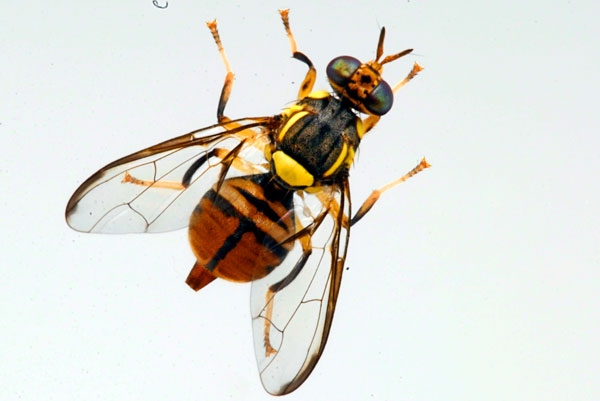The Queensland fruit fly (Q fly) is a pest familiar to most fruit growers in eastern Australia and ranges from the high tropics to the outskirts of Melbourne.
It feeds on citrus, stone fruit, apple and pears, pawpaw, guava, mango, avocado, carambola and a host of other fruit.
It is steadily moving south. There has recently been an incursion into Tasmania. This is not news to Australian fruit growers,
Oriental fruit fly distribution
In China, there is a species of fruit fly with remarkably similar habits. It is the Oriental fruit fly Bactrocera dorsalis (OFF).
Its western most outpost is Hawaii where it was introduced many years ago and has resisted attempts at eradication ever since.
It occurs naturally in New Guinea, Taiwan, the Philippines in the East; well up into China where only the cold limits its northern spread.
Just as Q fly is moving south in Australia, OFF is moving north. It extends right across South-East Asia and the Indian subcontinent and Sri Lanka.
Recently it entered sub-saharan Africa from Sri Lanka. In Africa it was initially known as Bactrocera invadens until found to be Oriental fruit fly B. dorsalis.
Under the name papaya fruit fly, B. dorsalis entered Australia in 1995. Thankfully, it was noticed early and was eradicated by 1999 after a major government campaign.
Life cycle and behaviour
OFF has a similar host range to Q fly. As adults, female OFF (and Q fly and Mediterranean fruit fly) go through several stages.
Newly emerged females (stage 1) need to develop their ovaries and they have a strong drive to find protein of the right sort.
These flies are bacteria feeders, mopping up films growing on leaf surfaces and rejoicing in bird poo when they can find it.
They can live for many weeks or months during which time their ovaries develop.
In stage 2, they are attracted to males and mate.
In stage 3 the females follow up the aromas and visual cues (colour, shape) that denote fruit and inject eggs through the fruit surface.
With the eggs, they deposit bacteria which start to rot the flesh of the fruit. When the eggs hatch, the little maggots have a bacterial soup on which to feed and grow.
Control of Oriental fruit fly
In many ways, the methods used to control of OFF are similar to the methods used for Q fly.
Systemic insecticides such as dimethoate are effective but their use is now tightly restricted. That means that the focus must be on adult control using attractants.
(cont next month)
See this article in Tree Fruit March 2018




















